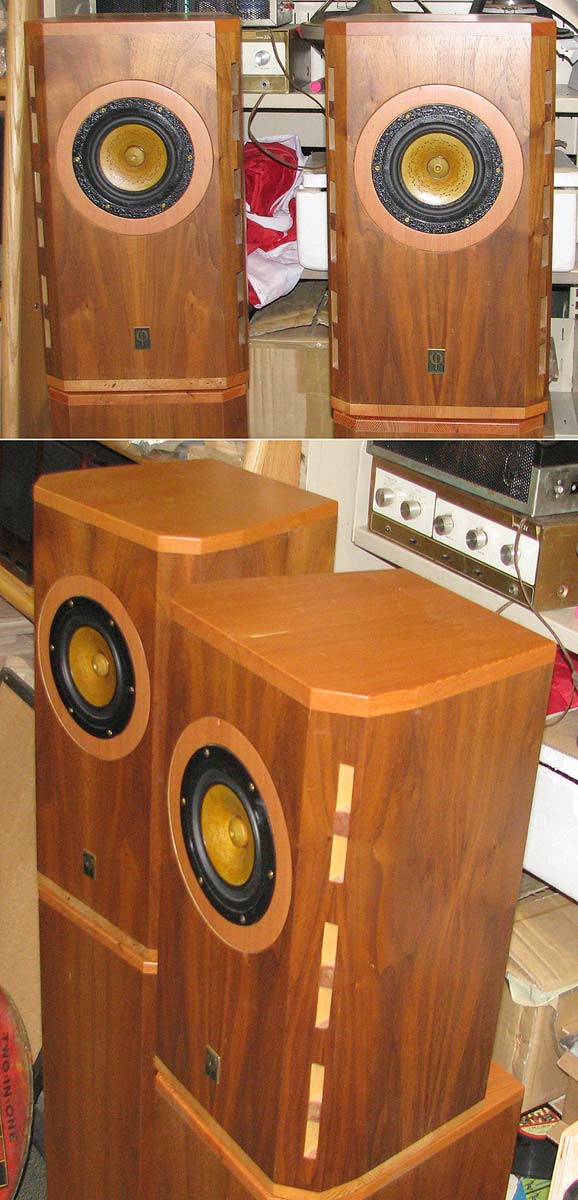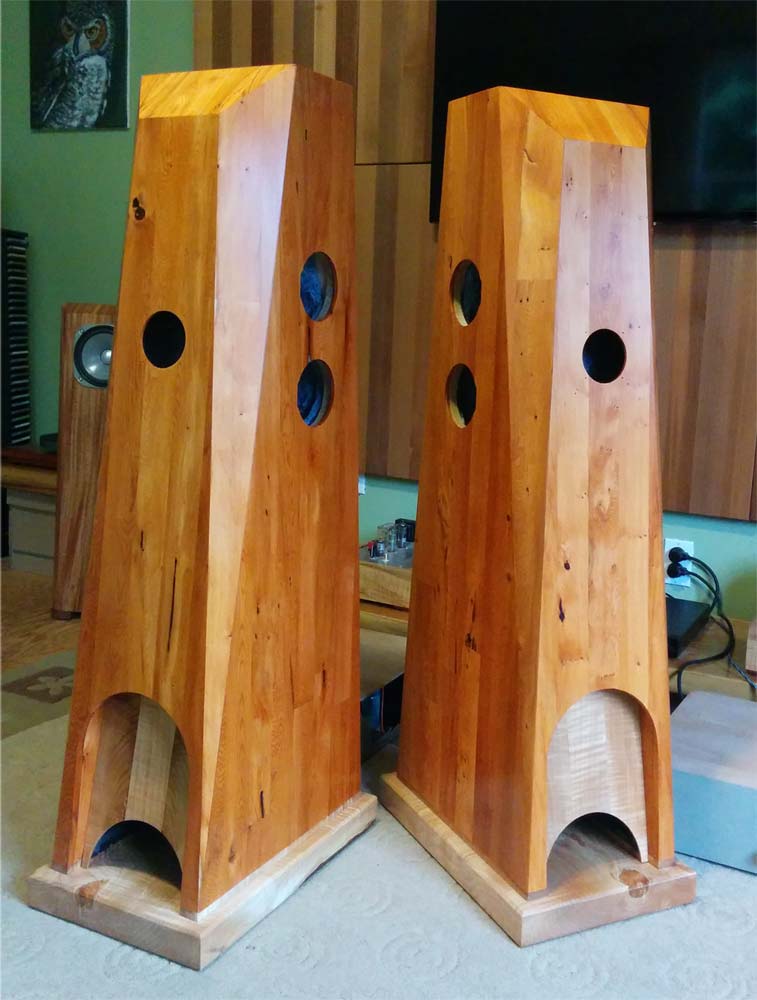Every panel, irrespective of shape, will have a resonant frequency. Trapezoidal panels will vibrate, it's not like they don't. Over the last 35+ years of building speaker boxes, I've built truncated pyramids of 4 and 5 sides, round, square rectangle, you name it. I think the biggest benefit with the pyramids, other than looking far more interesting than a plain box, is the potential to time align the drivers and gain the benefits of better edge defraction.
Narrow cabinets tend to image better than wider ones and I suspect that it is the effect of the same frequencies that typically occur in a wider box, or so I guess. I've heard hundreds of speakers over the years and though I've heard small speakers that didn't image well, I've never heard a big box that images well (not to say there might be exceptions, but that's not my experience).
With a pyramid, you can keep the area next to the tweeter narrow, but still arrive at a volume large enough for a 5 1/4-6 1/2, maybe a bit larger driver for the base. Of course, there are other ways of doing that which are effective, but once you get the jigs set up, making pyramids is actually quite easy. Maybe a tutorial in a woodworking subforum would be useful?
One of the toughest box did was a skewed truncated pyramid -- back was square, sides were sloped 7 1/2 degrees and the front was sloped 15 degrees. Done in a nice white oak with inlaided hardwood corners, it was very sweet, but as others have noted it really does take a lot of extra time. So, though I can build an elaborate box, I often choose not to. The reason that you don't frequently see those types of boxes much commercially is the cost of the enclosure relative to the overall speaker budget. When you are building for yourself, you can do what you want irrespective of cost or benefit.
Narrow cabinets tend to image better than wider ones and I suspect that it is the effect of the same frequencies that typically occur in a wider box, or so I guess. I've heard hundreds of speakers over the years and though I've heard small speakers that didn't image well, I've never heard a big box that images well (not to say there might be exceptions, but that's not my experience).
With a pyramid, you can keep the area next to the tweeter narrow, but still arrive at a volume large enough for a 5 1/4-6 1/2, maybe a bit larger driver for the base. Of course, there are other ways of doing that which are effective, but once you get the jigs set up, making pyramids is actually quite easy. Maybe a tutorial in a woodworking subforum would be useful?
One of the toughest box did was a skewed truncated pyramid -- back was square, sides were sloped 7 1/2 degrees and the front was sloped 15 degrees. Done in a nice white oak with inlaided hardwood corners, it was very sweet, but as others have noted it really does take a lot of extra time. So, though I can build an elaborate box, I often choose not to. The reason that you don't frequently see those types of boxes much commercially is the cost of the enclosure relative to the overall speaker budget. When you are building for yourself, you can do what you want irrespective of cost or benefit.
Last edited:
I've stuck my entire head into a freshly-built speaker enclosure a few times. It is very revealing what you hear with your head inside the box.
There is always ambient white-noise in our environment these days (air-conditioning, cooling fans, traffic, aircraft flying overhead), and the spectrum of that broad-band noise changes dramatically inside the box. It always sounds incredibly "boxy", to the point where I can understand why some people become so horrified they start building open-baffle speakers (which, unfortunately, have even worse frequency-response problems than enclosed speakers do.)
Why do you say that? If you want to avoid a boxy sound, the easiest way to avoid it is with open-baffle. Needs EQ, of course, and you need room space to accommodate - also, possible problems with excursion (and therefore distortion). But frequency-response problems?
As said a triangle is somewhat harder to make and is not as volume efficient as a shape with more sides.
The trapezoidal miniOnkens would all fall into the truncated triangle class.

dave
The trapezoidal miniOnkens would all fall into the truncated triangle class.

dave
The Onkens look lovely, but I can't help feeling that the slight tapering is having very little effect on resonances. But I may be wrong...
At least they're more pleasing than those faceted monstrosities that look like wind-blown daleks
Like these? A real MF to build.

dave
Nice enclosures Dave.
I do keep waiting for a bird to stick his head out of one of the upper ports.
I do keep waiting for a bird to stick his head out of one of the upper ports.
To my surprise, the pyramid shape, comprised of 4 equilateral triangle surfaces, required significantly lower surface area compared to the sphere and cube for a given volume!
I hate to be pedantic about this, but the above statement (regarding lowest surface area for a given volume) is not correct. In fact the sphere the absolute lowest surface to volume ratio of any shape. In nature, energy is required to create surface area from bulk material. This is why in absence of any other forces a drop of water will take on the shape of a sphere. You can see this demonstrated experimentally via videos taken on the ISS or the vomit comet.
Reference:
geometry - Why do water drops form spheres in space? - Physics Stack Exchange
Surface tension - Wikipedia
Related reading here:
Spherical ice cubes and surface area to volume ratio | MrReid.org
This web page on the topic is interesting. Near the top it gives a table comparing As/V for some different shapes plus the sphere.
Hey, stay in school, kids. Science is cool.
"dodecahedron speaker"
A structure that is a simplier version of Bucky’ds geodesic dome. I have drivers for a pair of those and for a corresponding woofer.
dave
The Onkens look lovely, but I can't help feeling that the slight tapering is having very little effect on resonances. But I may be wrong...
If one looks at the math evern heavily tapered boxes have little internal affect. The main purpose of this shape is to reduce the diffraction signature and the big chamfers on the sides and front corners are important for that.
dave
On the topic of rectangular on the outside and triangular on the inside here is a modern B139 TL Scott & i did, the original was in the’70s for B200 and very much inspired by Bailey’s TTL. It is not only triangular but tapers.
http://p10hifi.net/TLS/downloads/B139-TTL-map-100707.pdf
dave
An externally hosted image should be here but it was not working when we last tested it.
http://p10hifi.net/TLS/downloads/B139-TTL-map-100707.pdf
dave
I'd think make it non-resonant on the inside, and non-resonant on the outside, and non-resonant in the room.If you want to avoid a boxy sound, the easiest way to avoid it is with open-baffle.
One exception might be a line array that uses a common rear volume.to suppress organ-pipe resonances, a long tubular enclosure sounds horrible
If you want to avoid a boxy sound, the easiest way to avoid it is with open-baffle.
It is not a cure-all. One of the boxiest sounding speakers i have heard were OBs.
dave
"On the topic of rectangular on the [outside] and triangular on the inside"
That reminds me of something that's been bugging me... the evident brief editing time frame.
Is there a way to go back later and fix an embarrassing typo? (I make a lot of 'em)
That reminds me of something that's been bugging me... the evident brief editing time frame.
Is there a way to go back later and fix an embarrassing typo? (I make a lot of 'em)
We don't normally edit posts, this maintains fairness. But if it's just an embarrassing typo, link to it and I'll fix it shortly, just this once.Is there a way to go back later and fix an embarrassing typo? (I make a lot of 'em)
I'm talking about me editing not you guys.
What I'd like is a slightly longer window of opportunity to fix inadvertent errors (not to pull a fast one on other commenters as you seem to fear?)
What I'd like is a slightly longer window of opportunity to fix inadvertent errors (not to pull a fast one on other commenters as you seem to fear?)
Both sides have played into making the current decision on the edit time. To save going off topic here however, may I encourage you to start a thread in this subforum - https://www.diyaudio.com/forums/forum-problems/
Nah, it's OK.
I was hoping the moderator who responded was p10 and he could have fixed his typo. 🙂
Thnaks! ;-)
I was hoping the moderator who responded was p10 and he could have fixed his typo. 🙂
Thnaks! ;-)
I tend to see things as markbakk (post#19), where standing waves can get rearranged in a box but don't necessarily disappear. The size of the box tends to be a factor in this despite it appearing only to be the shape. Mix this with some damping material and the problem begins to go away.
The outside of the box tends to be more dependent on shape in practise, it's effect is critical and it also can't just be treated like a black hole.
The outside of the box tends to be more dependent on shape in practise, it's effect is critical and it also can't just be treated like a black hole.
Oh, he's alright.. you'd have to be to navigate those quaint iPad virtual keyboards 😀mhenschel said:I was hoping the moderator who responded was p10 and he could have fixed his typo. 🙂
Thnaks! ;-)
- Home
- Loudspeakers
- Multi-Way
- Why are triangular enclosures not more common here?